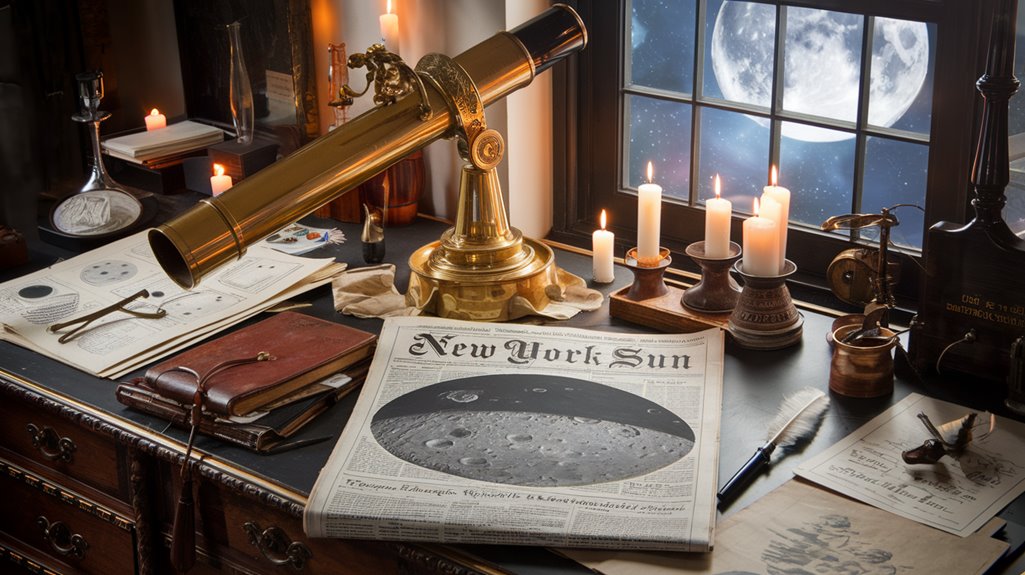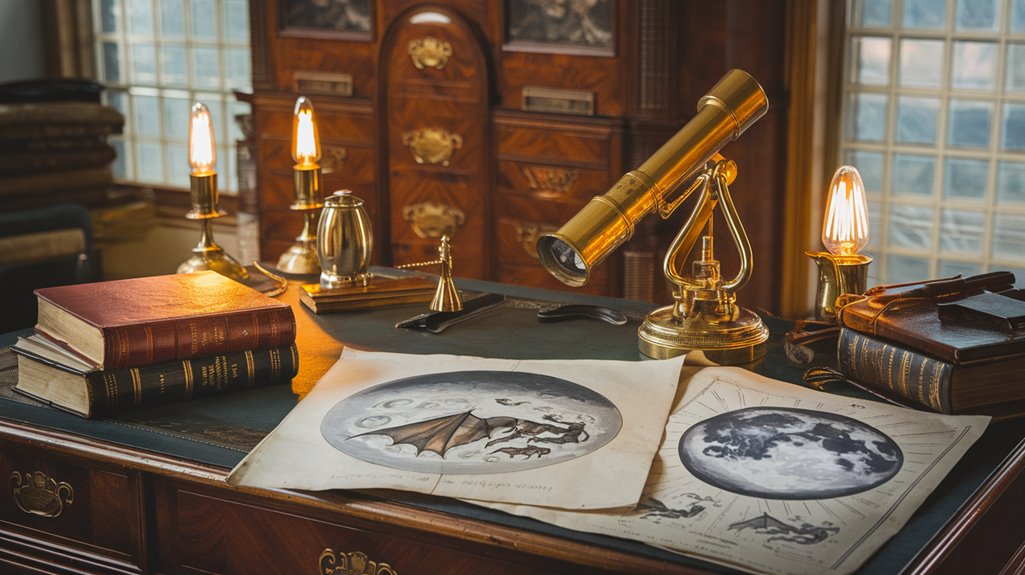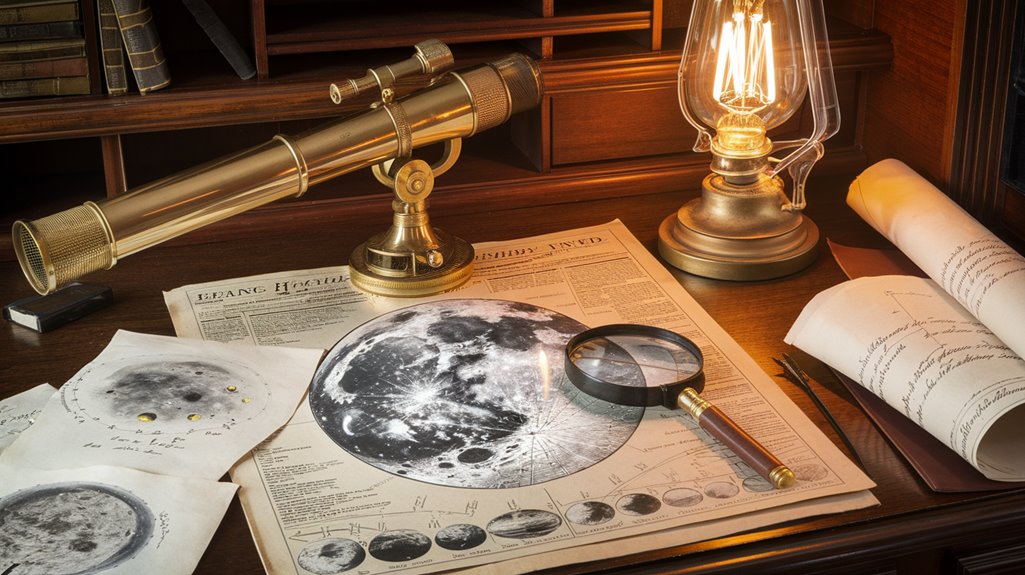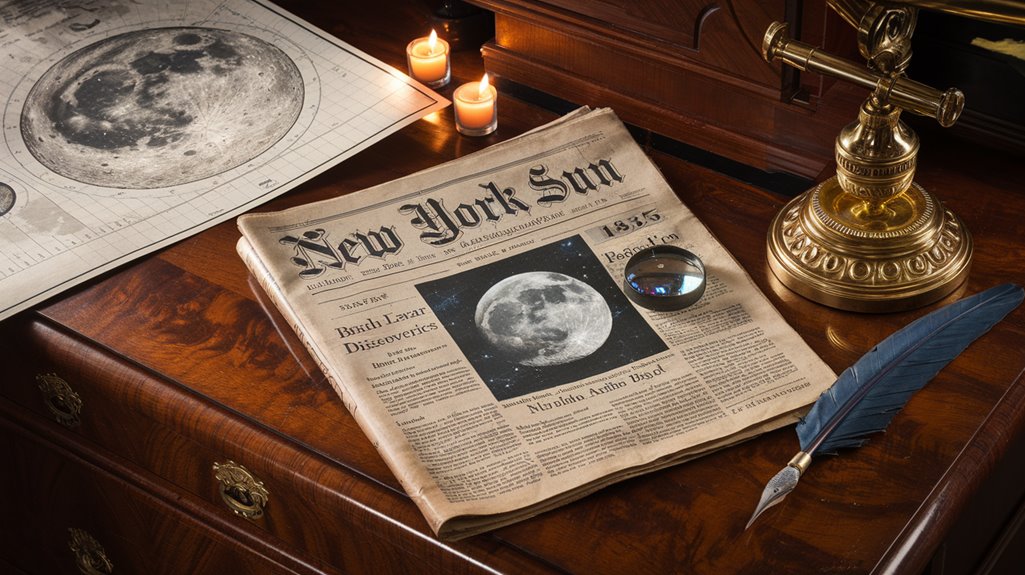A Newspaper Claimed Moon Life Discovery in 1835
Did you know that in 1835, the New York Sun increased its circulation from 8,000 to 19,000 copies in just two weeks? You've likely heard of modern media hoaxes, but this 19th-century paper pulled off one of history's most audacious scientific deceptions. Through a series of convincing articles, they convinced thousands of New Yorkers that astronomers had discovered bat-winged humanoids and unicorns living on the moon. The story behind this elaborate hoax reveals surprising truths about media, science, and human nature.
The Birth of a Lunar Sensation

While the New York Sun was already known for its affordable penny pricing, it was the publication of the Great Moon Hoax in August 1835 that truly catapulted the newspaper to prominence. The paper had achieved the highest circulation of any American newspaper by 1834.
You'd be amazed to learn how this series of six articles created an entirely new lunar mythology, describing fantastic civilizations and creatures on the moon's surface. The articles detailed incredible sightings of miniature bison and unicorns among other bizarre creatures supposedly inhabiting the lunar landscape.
The hoax cleverly capitalized on media sensationalism by incorporating real scientific figures like Sir John Herschel and referencing the Edinburgh Journal of Science to boost credibility.
Even respected publications like The New Yorker and The New York Times fell for the elaborate deception.
Though the hoax was revealed on September 16, 1835, it had already achieved its satirical aim of critiquing religious influence in scientific discovery while dramatically boosting the Sun's readership.
Inside the Moon Hoax Articles
As *The New York Sun* began publishing its lunar discoveries on August 25, 1835, readers were treated to an elaborate tale of moon-dwelling creatures and civilizations, all supposedly observed through a revolutionary 24-foot telescope.
Through fictional astronomy, the articles described a lunar world teeming with life. You'd have found bison and goats roaming the surface, alongside fantastic creatures like unicorns and bipedal beavers.
Most remarkably, the papers detailed winged humanoids called "Vespertilio-homo" who'd built temples on the Moon's surface. Through sensational storytelling, the articles painted a vivid picture of lunar oceans, beaches, and trees. The story was actually written by Richard Adams Locke, who later admitted to creating the hoax in 1840.
The supposed observations came from a massive telescope that allegedly weighed 7 tons and had been transported from New England to South Africa, where the Sun eventually destroyed it by setting it ablaze. While many readers were initially captivated by these discoveries, Yale scientists investigated the claims by trying to locate the non-existent Edinburgh Journal of Science where the findings were supposedly first published.
The Imaginative World Above
The imaginative lunar world portrayed in the hoax emerged from a peculiar blend of religious influence and scientific speculation.
You'd have found yourself immersed in detailed descriptions of lunar ecosystems teeming with life, from dense forests to miniature bison roaming the surface. The articles painted a picture of fantastical fauna, including single-horned goats and winged humans known as Vespertilio-homo, enchanting readers' imaginations.
Through a supposedly powerful telescope at the Cape of Good Hope, you would've witnessed these extraordinary creatures living in harmony on the Moon's surface. The New-York Sun newspaper published these incredible findings over six consecutive days in late August 1835.
The narrative cleverly built up to its climactic revelation of the man-bats, perhaps the most sensational claim of all.
Unfortunately, this fascinating window into lunar life came to an abrupt end when the telescope's lens allegedly caught fire.
Public Response and Media Impact
Following its publication in 1835, widespread fervor gripped readers across America as they absorbed every detail of the supposed lunar discoveries.
Religious leaders and scholars enthusiastically debated the implications of life on the moon, while newspapers nationwide reprinted the sensational stories.
However, public skepticism emerged quickly through rival publications. The Journal of Commerce and New York Herald denounced the series as fraudulent, sparking heated editorial battles with The Sun.
These conflicts raised significant questions about media ethics and journalistic integrity. Similar to today's excitement about NASA's plans to land at the lunar South Pole with Artemis.
The stories described fantastic creatures including bat-like humanoids living in temples on the moon's surface. You'll find the hoax's influence extended far beyond its time, inspiring writers like Jules Verne and prompting vital discussions about the responsibility of newspapers to verify facts.
The incident became a turning point in American journalism, highlighting the delicate balance between entertainment and truthful reporting in the emerging penny press era.
The Masterminds and Their Motives

Behind this astronomical deception stood Richard Adams Locke, a cunning editor at The New York Sun who orchestrated what would become history's most famous lunar hoax.
His mastermind motivations went beyond mere entertainment – he crafted the elaborate tale as a satirical commentary on public gullibility and media credibility.
To make his story convincing, Locke cleverly attributed the fictional discoveries to the respected astronomer Sir John Herschel, while creating an imaginary companion named Andrew Grant.
You'll notice how he exploited the public's fascination with space exploration and potential alien life to boost the newspaper's circulation.
The articles featured incredible descriptions of unicorns and man-bats inhabiting the lunar surface.
Though designed as satire, the hoax demonstrated the press's powerful influence over public opinion.
Even after the Sun admitted the fabrication, their readership remained largely unaffected.
Legacy in Science Journalism
While initially seen as mere entertainment, this astronomical deception left an indelible mark on science journalism that still resonates today. The hoax sparked essential conversations about misinformation ethics and media responsibility, forcing journalists to confront their duty to verify extraordinary claims before publication.











